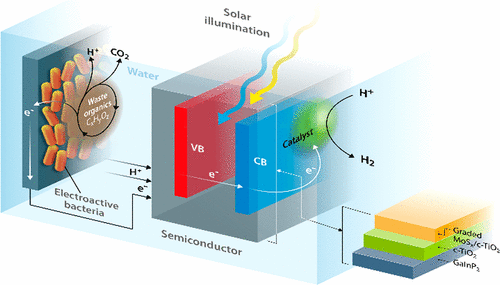当前位置:
X-MOL 学术
›
Environ. Sci. Technol.
›
论文详情
Our official English website, www.x-mol.net, welcomes your
feedback! (Note: you will need to create a separate account there.)
Microbial Photoelectrosynthesis for Self-Sustaining Hydrogen Generation
Environmental Science & Technology ( IF 10.8 ) Pub Date : 2017-11-07 00:00:00 , DOI: 10.1021/acs.est.7b03644 Lu Lu 1 , Nicholas B. Williams 2 , John A. Turner 3 , Pin-Ching Maness 3, 4 , Jing Gu 2 , Zhiyong Jason Ren 1
Environmental Science & Technology ( IF 10.8 ) Pub Date : 2017-11-07 00:00:00 , DOI: 10.1021/acs.est.7b03644 Lu Lu 1 , Nicholas B. Williams 2 , John A. Turner 3 , Pin-Ching Maness 3, 4 , Jing Gu 2 , Zhiyong Jason Ren 1
Affiliation

|
Current artificial photosynthesis (APS) systems are promising for the storage of solar energy via transportable and storable fuels, but the anodic half-reaction of water oxidation is an energy intensive process which in many cases poorly couples with the cathodic half-reaction. Here we demonstrate a self-sustaining microbial photoelectrosynthesis (MPES) system that pairs microbial electrochemical oxidation with photoelectrochemical water reduction for energy efficient H2 generation. MPES reduces the overall energy requirements thereby greatly expanding the range of semiconductors that can be utilized in APS. Due to the recovery of chemical energy from waste organics by the mild microbial process and utilization of cost-effective and stable catalyst/electrode materials, our MPES system produced a stable current of 0.4 mA/cm2 for 24 h without any external bias and ∼10 mA/cm2 with a modest bias under one sun illumination. This system also showed other merits, such as creating benefits of wastewater treatment and facile preparation and scalability.
中文翻译:

微生物光电化学合成自持氢
当前的人工光合作用(APS)系统有望通过可运输和可储存的燃料来储存太阳能,但是水氧化的阳极半反应是一种能源密集型过程,在许多情况下,其与阴极半反应的耦合很差。在这里,我们展示了一种自我维持的微生物光电合成(MPES)系统,该系统将微生物电化学氧化与光电化学减水配对以实现高能效H 2一代。MPES降低了总能量需求,从而大大扩展了可用于APS的半导体范围。由于通过温和的微生物处理过程从废有机物中回收了化学能,并利用了经济高效且稳定的催化剂/电极材料,我们的MPES系统在24小时内可产生0.4 mA / cm 2的稳定电流,而没有任何外部偏压和10 mA / cm 2,在一个阳光照射下具有适度的偏压。该系统还显示了其他优点,例如为废水处理带来了好处,并且易于制备和扩展。
更新日期:2017-11-07
中文翻译:

微生物光电化学合成自持氢
当前的人工光合作用(APS)系统有望通过可运输和可储存的燃料来储存太阳能,但是水氧化的阳极半反应是一种能源密集型过程,在许多情况下,其与阴极半反应的耦合很差。在这里,我们展示了一种自我维持的微生物光电合成(MPES)系统,该系统将微生物电化学氧化与光电化学减水配对以实现高能效H 2一代。MPES降低了总能量需求,从而大大扩展了可用于APS的半导体范围。由于通过温和的微生物处理过程从废有机物中回收了化学能,并利用了经济高效且稳定的催化剂/电极材料,我们的MPES系统在24小时内可产生0.4 mA / cm 2的稳定电流,而没有任何外部偏压和10 mA / cm 2,在一个阳光照射下具有适度的偏压。该系统还显示了其他优点,例如为废水处理带来了好处,并且易于制备和扩展。











































 京公网安备 11010802027423号
京公网安备 11010802027423号